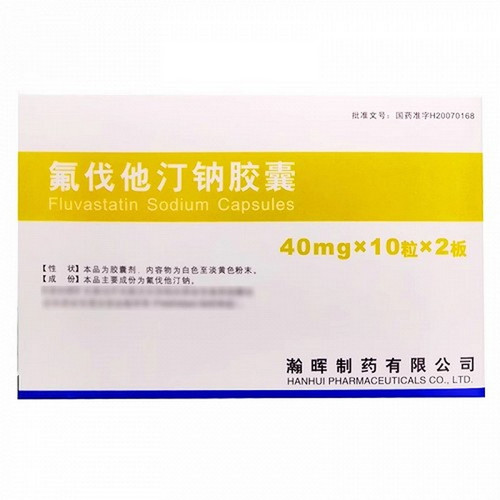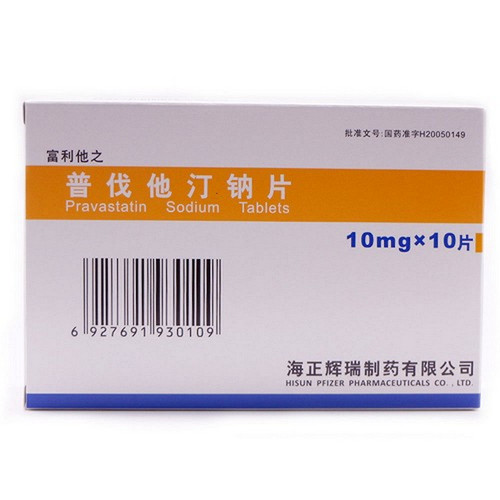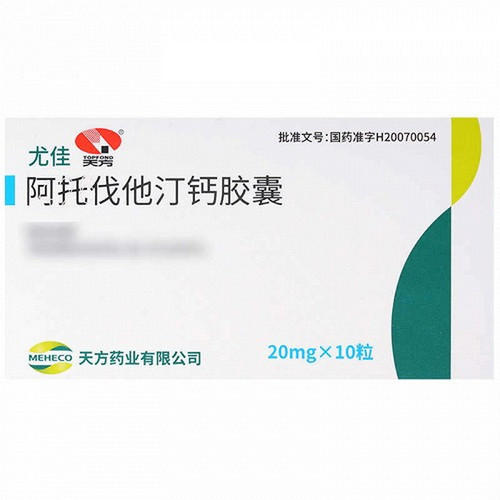Product Overview
[Drug Name]
Generic Name: Fluvastatin Sodium Capsules
Trade Name: Hanhui Fluvastatin Sodium Capsules 20mg x 20 capsules
[Main Ingredient]
Fluvastatin sodium.
[Properties]
This product is a capsule containing an off-white to slightly yellow granular powder.
[Indications/Main Function]
For primary hypercholesterolemia and primary mixed dyslipidemia (Fredrickson types IIa and IIb) that are not adequately controlled by diet.
[Precautions]
1. Liver Function: As with other lipid-lowering drugs, all patients should undergo liver function tests before starting this medication and regularly after the 12th week of treatment or when the dose is increased. If alanine aminotransferase (ALT) or aspartate aminotransferase (AST) levels are elevated by more than three times the upper limit of normal, the drug should be discontinued. There have been isolated reports of possible drug-induced hepatitis, which resolved after discontinuation of the drug. 2. Use with caution in patients with liver disease or those who consume significant amounts of alcohol. 3. Skeletal Muscle Function: Myopathy (including myositis and rhabdomyolysis) has been reported in patients taking other HMG-CoA reductase inhibitors. Reports of myopathy are rare with fluvastatin use, and myositis and rhabdomyolysis are extremely rare. If unexplained diffuse muscle pain, tenderness, or weakness and/or a significant elevation in creatine kinase (CK) levels occur, consider myopathy, myositis, or rhabdomyolysis. Therefore, patients should be advised to report any of these conditions immediately, particularly if accompanied by weakness or fever. Regardless of whether a muscle-related disorder is confirmed, fluvastatin therapy should be discontinued if CK levels are significantly elevated (greater than 5 times the upper limit of normal). 4. Creatine Kinase Measurement: Currently, there is no evidence to support routine monitoring of plasma creatine kinase or other muscle-related enzymes in patients taking statins in the absence of symptoms. If creatine kinase is measured, strenuous exercise should be avoided or any other condition suspected of causing CK elevations should be present, as this can complicate interpretation and analysis. 5. Pre-treatment: As with other statins, fluvastatin should be used with caution in individuals at risk for rhabdomyolysis and its complications. Creatine kinase levels should be measured before use in the following situations: renal impairment; hypothyroidism; family or personal history of hereditary myopathies; history of myotoxicity from previous statin or fibrate use; alcoholism; and in elderly patients (>70 years of age), the need for measurement should be determined based on the presence of other risk factors for rhabdomyolysis. In these situations, physicians should assess the risks and benefits of treatment and conduct clinical monitoring. If the CK level is significantly elevated (greater than 5 times the upper limit of normal) at baseline, a repeat measurement should be performed 5-7 days later to confirm the result. If the CK level remains significantly elevated (greater than 5 times the upper limit of normal), treatment should not be initiated. During treatment: If muscle-related symptoms such as pain, weakness, or cramping occur in patients receiving fluvastatin, the CK level should be measured. If the CK level is significantly elevated (greater than 5 times the upper limit of normal), treatment should be discontinued. If severe muscle symptoms occur that make daily life difficult, discontinuation of treatment should be considered, even if the CK level is ≤5 times the upper limit of normal. If symptoms resolve and the CK level returns to normal, reinitiation of the lowest dose of fluvastatin or other statins under close monitoring may be considered. There have been reports of an increased risk of myopathy when statins are used in combination with immunosuppressive drugs (including cyclosporine), fibrates, niacin, or erythromycin. However, this phenomenon was not observed in clinical trials with the combined use of fluvastatin and niacin, fibrates, or cyclosporine. Post-marketing surveillance has identified isolated cases of myopathy following the combined use of fluvastatin and cyclosporine or fluvastatin and colchicine. This product should be used with caution in such patients (see [Drug Interactions]). 7. Homozygous familial hypercholesterolemia. There are no clinical data on the use of fluvastatin in this rare condition.
[Drug Interactions]
1. Patients with known hypersensitivity to fluvastatin or any other component of the drug. 2. Patients with active liver disease or persistent unexplained transaminase elevations. 3. Pregnant and lactating women, as well as women of childbearing age who are not using reliable contraceptive measures. 4. Patients with severe renal insufficiency.
[Pediatric Use]
Due to the lack of clinical experience with fluvastatin in patients under 18 years of age, this drug is not recommended for use in patients under 18 years of age.
[Elderly Use]
Clinical studies have demonstrated that this drug is effective and well-tolerated in patients 65 years of age and younger. Efficacy is enhanced in elderly patients (>65 years of age), and tolerability is not decreased; therefore, no dose adjustment is required.
[Pregnancy and Lactation Use]
Pregnancy: Because HMG-CoA reductase inhibitors reduce cholesterol synthesis and may reduce the synthesis of certain biologically active cholesterol derivatives, use by pregnant women may be harmful to the fetus. Therefore, this drug is contraindicated in pregnant women. It is also contraindicated in women of childbearing age who are not using reliable contraceptive measures. If pregnancy occurs during treatment, this drug should be discontinued. This drug is contraindicated in breastfeeding women.
[Specifications]
20 mg x 20 tablets (Hanhui)
[Dosage and Administration]
Patients must maintain a low-cholesterol diet before and during treatment with this drug. Usual dose: The recommended dose is 20 or 40 mg once daily. Take with the evening meal or at bedtime. The dosage should be adjusted based on individual response to medication and dietary therapy and accepted treatment guidelines. For patients with very high cholesterol or poor response to medication, the dose can be increased to 40 mg twice daily. Maximum LDL-C lowering is achieved within four weeks of administration. Long-term efficacy persists. Dosage for Patients with Renal Impairment: Because this drug is almost entirely cleared by the liver, with less than 6% excreted in the urine, no dosage adjustment is necessary for patients with mild to moderate renal impairment. This drug should not be used in patients with severe renal impairment.
[Adverse Reactions]
The most common adverse drug reactions are mild gastrointestinal symptoms, insomnia, and headache. Laboratory Abnormalities: As with other HMG-CoA reductase inhibitors and lipid-lowering drugs, fluvastatin may cause abnormal liver function biochemical tests. A small number of patients (1-2%) experience transaminase levels exceeding three times the upper limit of normal. In a very small number of patients (0.3%-1.0%), creatine kinase (CK) levels exceed five times the upper limit of normal.
[Contraindications]
1. Patients with known hypersensitivity to fluvastatin or any other component of the drug.
2. Patients with active liver disease or persistent unexplained transaminase elevations.
3. Pregnant and lactating women, as well as women of childbearing age who are not using reliable contraceptive measures.
4. Patients with severe renal insufficiency.
[Overdose]
In a placebo-controlled study of 40 patients with hypercholesterolemia, fluvastatin sodium extended-release tablets were well tolerated at doses up to 320 mg/day (n=7 per dose group) for over 2 weeks. In the event of an overdose, no specific measures or recommendations are available. Symptomatic and supportive treatment may be used as necessary.
[Pharmacology and Toxicology]
This product is a fully synthetic cholesterol-lowering drug that acts as an inhibitor of hydroxymethylglutaryl coenzyme A (HMG-CoA) reductase, which converts HMG-CoA to 3-methyl-3,5-dihydroxyvaleric acid. This drug acts in the liver, inhibiting endogenous cholesterol synthesis, reducing cholesterol levels in hepatocytes, stimulating the synthesis of low-density lipoprotein (LDL) receptors, increasing LDL particle uptake, and lowering total plasma cholesterol concentrations. The drug's effect on coronary atherosclerosis was studied using quantitative coronary angiography in male and female patients aged 35-75 years with mild-to-moderate cholesterolemia (baseline LDL-C 115-190 mg/dL, or 3.0-4.9 mmol/L) and coronary heart disease (CHD).
[Pharmacokinetics]
1. Absorption: Fluvastatin is rapidly absorbed after fasting administration in healthy volunteers, reaching peak plasma concentrations within 1 hour and with an absolute bioavailability of 24% (9-50%). Food intake affects bioavailability but does not prolong absorption. At steady-state, administration immediately after a meal results in a 2-fold decrease in Cmax and a 2-fold increase in Tmax compared to administration 4 hours after a meal. After single or multiple doses of more than 20 mg, fluvastatin exhibits a saturated first-pass effect, resulting in a significant increase in the concentration of fluvastatin in the plasma. 2. Distribution: Fluvastatin acts mainly on the liver, which is also the main organ for its metabolism. The apparent volume of distribution (Vz/f) of fluvastatin is 330 liters. More than 98% of the circulating drug is bound to plasma proteins, and this binding is unrelated to the blood concentrations of fluvastatin, warfarin, salicylic acid and glibenclamide. 3. Metabolism: Fluvastatin is mainly metabolized in the liver. The circulating drugs are mainly the original fluvastatin and the pharmacologically inactive metabolite N-desisopropylpropionic acid. Hydroxylated metabolites are pharmacologically active but do not enter the systemic blood circulation. The metabolic pathways of fluvastatin in the human liver have been elucidated. Fluvastatin biotransformation occurs via multiple alternative cytochrome P450 (CYP) pathways, which minimizes the impact of CYP450 inhibition on fluvastatin metabolism. Inhibition of CYP450 isoenzymes is a major cause of drug interactions. Several in vitro studies have investigated the inhibitory effects of fluvastatin on CYP2C9 isoenzymes. Fluvastatin only inhibits the metabolism of compounds metabolized by CYP2C9. This suggests the possibility of competitive interactions between fluvastatin and compounds that are CYP2C9 substrates, including dichlorophen, phenytoin, tolbutamide, and warfarin, but clinical data have not yet been confirmed. 4. Elimination: After administration of H-labeled fluvastatin to healthy volunteers, approximately 6% of the radioactivity was found in the urine and 93% in the feces, resulting in excretion of less than 2% of the total labeled fluvastatin. The plasma clearance rate (CL/f) of fluvastatin is 1.8±0.8 l/min. Steady-state plasma concentrations of fluvastatin at 80 mg/day do not show an accumulation effect. The terminal half-life after oral administration of 40 mg is 2.3±0.9 hours. There is no significant difference in the AUC between fluvastatin taken simultaneously with dinner and when taken 4 hours after dinner. 5. Pharmacokinetics in Special Circumstances: In the general population, the plasma concentration of fluvastatin does not change with age or gender. However, an enhanced therapeutic response has been found in women and the elderly. Because fluvastatin is primarily excreted via the bile and undergoes significant biotransformation before entering the systemic circulation, the possibility of accumulation cannot be ruled out in patients with hepatic insufficiency. Fluvastatin sodium should be used with caution in patients with a history of liver disease and those who consume excessive alcohol. The AUC and Cmax of fluvastatin increase to 2.5 times the normal level in patients with hepatic insufficiency. This is mainly due to decreased metabolism caused by hepatic insufficiency.






